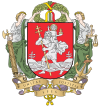Vilnius
Vilnius (Lithuanian pronunciation: [ˈvʲɪlʲnʲʊs] (listen), hilingon man an ibang ngaran) an kapitolyo kan Lithuania asin pinakadakulang syudad, na igwang populasyon 574,147 kan 2018[update].[9] An Vilnius nasa sur subangan nin Lithuania asin ikaduwa sa pinakadakulang syudad sa Baltic states. Ini man an puwesto kan mga institusyon nin gobyerno sa Lithuania asin Vilnius District Municipality. Ini man an Vilnius tinuturing Gamma global city base sa pag aadal kan GaWC, midbid man sa arkitektura kan Old Town, na dineklara nin UNESCO World Heritage Site kan 1994.[10]Bago an World War II, an Vilnius ang saro sa pinakadakulang sentro kan mga Hudyo sa Europa. Inapod ini na "Jerusalem of Lithuania" dahil sa impluwensya kan mga Hudyo asin pinangaranan ini ni Napoleon na "the Jerusalem of the North"[11] kan nag agi sya kan 1812. Kan 2009, an Vilnius naging European Capital of Culture, kaibanan an Austrian city kan Linz.[12]
Vilnius | |||||
|---|---|---|---|---|---|
 Clockwise from top right: Gediminas' Tower, Vilnius business district, Presidential Palace, Pilies Street, Gate of Dawn, St. Anne's Church. | |||||
| |||||
| Mga palayaw: | |||||
| Motto: Unitas, Justitia, Spes (Latin: Unity, Justice, Hope) | |||||
 Interactive map of Vilnius | |||||
| Lua error in Module:Mapa_nin_kinamumugtakan at line 485: Dae mahanap an ispesipikong depinisyon kan mapa nin kinamumugtakan: "Module:Mapa nin kinamumugtakan/datos/Lithuania" an nag-iiral. | |||||
| Tagboan: 54°41′N 25°17′E / 54.683°N 25.283°ETagboan: 54°41′N 25°17′E / 54.683°N 25.283°E | |||||
| Country | Plantilya:LIT | ||||
| County | |||||
| Municipality | Vilnius City Municipality | ||||
| Capital of | Lithuania | ||||
| First mentioned | 1323 | ||||
| Elderships | |||||
| Pamamahala | |||||
| • Tipo | City council | ||||
| • Mayor | Remigijus Šimašius (Liberal) | ||||
| Hiwas | |||||
| • City | 401 km2 (155 sq mi) | ||||
| • Metro | 9,731 km2 (3,757 sq mi) | ||||
| Elebasyon | 112 m (367 ft) | ||||
| Populasyon (2018)[6] | |||||
| • City | 574,147 | ||||
| • Ranggo | (53rd in EU) | ||||
| • Densidad | 1,392/km2 (3,610/sq mi) | ||||
| • Urban | 641,220 | ||||
| • Metro | 805,367including Vilnius County | ||||
| • Densidad kan metro | 83/km2 (210/sq mi) | ||||
| Mga demonym | Vilnian | ||||
| Sona nin oras | UTC+2 (EET) | ||||
| • Tig-init (DST) | UTC+3 (EEST) | ||||
| Postal code | 01001-14191 | ||||
| Area code(s) | (+370) 5 | ||||
| GDP (nominal) Vilnius county[7] | 2017 | ||||
| - Total | €17.2 billion($38 billion, PPP) | ||||
| - Per capita | €21,300($47,000, PPP) | ||||
| HDI (2017) | 0.896[8] – very high | ||||
| Websityo | www | ||||
| Opisyalmenteng Pangaran | Historic Centre of Vilnius | ||||
| Tipo | Cultural | ||||
| Krayterya | ii, iv | ||||
| Pigdisignar | 1994 (18th session) | ||||
| nu. nin tagboan | [1] | ||||
| UNESCO region | Europe | ||||
Mga toltolan
baguhon- ↑ Widespread nickname of Vilnius, that appeared because of a strong Litvak community. Today it is used primarily speaking about the past of the Jewish community of Vilnius, e.g. A book "Vilnius, in search of Jerusalem of Lithuania".
- ↑ Widespread use of the nickname from the XVI c. to this day as a reference to the many Catholic churches and monasteries in Vilnius and overall religious atmosphere in the centre. This nickname was/is used not only by the foreigners, but also by the local population, e.g. Lithuanian cultural figure of the XIX c. Dionizas Poška nicknamed Vilnius "Rome of the North", as, according to him, Vilnius is "the old religious centre, that transformed from a pagan city into the bastion of Christianity". D. Poška, ‘Raštai’, Vilnius, 1959, p. 67
- ↑ Cultural newspaper, that is published in Vilnius from 1990, is named „Šiaurės Atėnai“ (The Athens of the North) as a reference to one of the nicknames of Vilnius, that was widespread nickname of the city, esp. in the first half of the XIX c. and the first half of the XX c. mostly because of Vilnius University. During the interwar period, Polish scientific newspaper, published in Vilnius, was also named "Atheneum Wileńskie".
- ↑ Esp. in the 16th–17th centuries, Vilnius was referred to as the ‘New Babylon’ because of many languages, spoken in the city as well as many religions presented (there were various Christian communities as well as Jews and even Muslim Tatar community). E.g.: S. Bodniak, ‘Polska w relacji włoskiej z roku 1604’, Pamiętnik biblioteki kórnickiej, 2, (Kórnik, 1930), p. 37.
- ↑ This nickname was very popular among the Lithuanian nobility, citizens of Vilnius and used among the poets, esp. during the Baroque period. Many poets of the period, including Maciej Kazimierz Sarbiewski, nicknamed Vilnius "the capital of Palemon" or "the city of Palemon". Živilė Nedzinskaitė, Vilnius XVII-XVIII a. LDK lotyniškojoje poezijoje, Acta Academiae Artium Vilnensis, Vilnius, 2010, p. 16; Eugenija Ulčinaitė, Motiejus Kazimieras Sarbievijus: Antikos ir krikščionybės sintezė; Vilniaus pasveikinimas, Lietuvių literatūros ir tautosakos institutas, Vilnius, 2001, p. 47, 59, 61, 63; etc.
- ↑ Lietuvos statistikos departamentas. "Lietuvos statistikos departamentas". osp.stat.gov.lt.
- ↑ "Statistinių rodiklių analizė". Statistics Lithuania.
- ↑ Sub-national HDI. "Area Database - Global Data Lab". hdi.globaldatalab.org (in English).
- ↑ Empty citation (help)
- ↑ Empty citation (help)
- ↑ .
- ↑ Empty citation (help)

